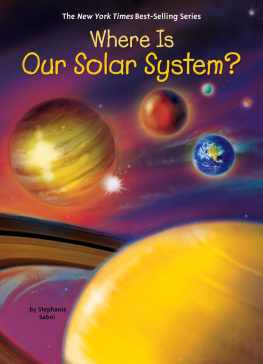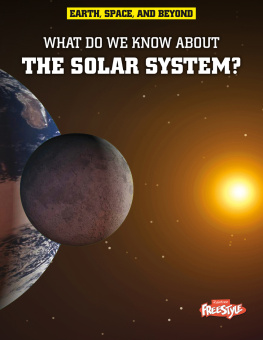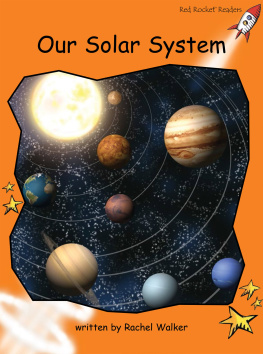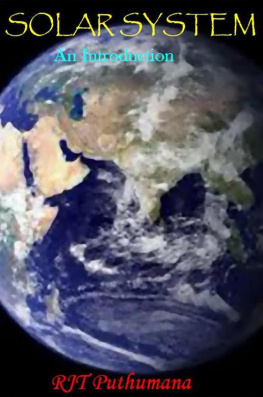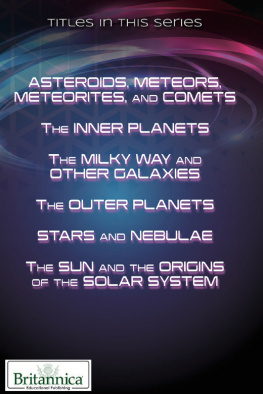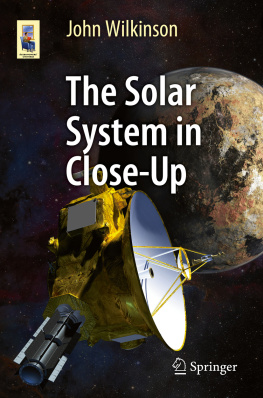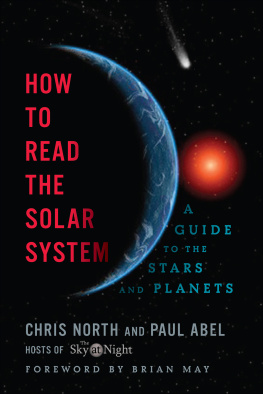Ian Niall Rankin - A New Look at the Solar System
Here you can read online Ian Niall Rankin - A New Look at the Solar System full text of the book (entire story) in english for free. Download pdf and epub, get meaning, cover and reviews about this ebook. year: 2016, publisher: The Book Guild, genre: Children. Description of the work, (preface) as well as reviews are available. Best literature library LitArk.com created for fans of good reading and offers a wide selection of genres:
Romance novel
Science fiction
Adventure
Detective
Science
History
Home and family
Prose
Art
Politics
Computer
Non-fiction
Religion
Business
Children
Humor
Choose a favorite category and find really read worthwhile books. Enjoy immersion in the world of imagination, feel the emotions of the characters or learn something new for yourself, make an fascinating discovery.
- Book:A New Look at the Solar System
- Author:
- Publisher:The Book Guild
- Genre:
- Year:2016
- Rating:5 / 5
- Favourites:Add to favourites
- Your mark:
- 100
- 1
- 2
- 3
- 4
- 5
A New Look at the Solar System: summary, description and annotation
We offer to read an annotation, description, summary or preface (depends on what the author of the book "A New Look at the Solar System" wrote himself). If you haven't found the necessary information about the book — write in the comments, we will try to find it.
A New Look at the Solar System is a book of vital importance of our species. Drawing on a staggering range of references across disciplines including geology, astronomy, archaeology and palaeontology, Ian Rankin outlines his radical ideas about the worlds past.
A New Look at the Solar System — read online for free the complete book (whole text) full work
Below is the text of the book, divided by pages. System saving the place of the last page read, allows you to conveniently read the book "A New Look at the Solar System" online for free, without having to search again every time where you left off. Put a bookmark, and you can go to the page where you finished reading at any time.
Font size:
Interval:
Bookmark:
A NEW LOOK AT THE SOLAR SYSTEM
Ian Niall Rankin MA (Oxon.)
Book Guild Publishing
Sussex, England
Published in Great Britain in 2015 by
The Book Guild Ltd
The Werks
45 Church Road
Hove, BN3 2BE
Originally published under the title Doomsday Just Ahead in 2004
Copyright Ian Niall Rankin 2004, 2015
The right of Ian Niall Rankin to be identified as the author of this work has been asserted by him in accordance with the Copyright, Designs and Patents Act 1988.
All rights reserved. No part of this publication may be reproduced, transmitted, or stored in a retrieval system, in any form or by any means, without permission in writing from the publisher, nor be otherwise circulated in any form of binding or cover other than that in which it is published and without a similar condition being imposed on the subsequent purchaser.
Typesetting in Times by
Keyboard Services, Luton, Bedfordshire
Printed and bound in Great Britain by
CPI Group (UK) Ltd, Croydon, CR0 4YY
A catalogue record for this book is available from
The British Library.
ISBN 978 1 910878 682
To my three children: ZARA, GAVIN and LACHLAN
Table of Contents
This is a strange book. It is divided into two parts, which at first glance do not belong within the same cover. But another look shows that, without the second part, the larger first section would lose much of the supporting argument it needs to explain the violent, yet fragile, behaviour of the Earth.
This fragility is what the first part of the book is about. In it I hope to show that one of the Suns satellites, in this case the Earth, is repeatedly changing its axis of rotation: it shifts its angle of tilt with respect to the ecliptic the average plane of the Earths orbit round the Sun and it also changes the location of the North and South Poles. Needless to say, with those changes often very rapid by human and not geological timescales goes devastation. In the past, floods and storms have exceeded anything we know today; and low-level wind speeds have breached the 1999-recorded 350 mph.
Received thinking on this violence does not agree. In the early nineteenth century a change of thinking had come about whereby belief that the Earths behaviour was sudden and very violent a feature of the previous century was replaced with a belief in gradualism: all major changes in the Earths behaviour were slow and rarely abrupt. This of course ushered in Darwinism. I believe there is considerable evidence for change that is extreme and oft-repeated, not simply those changes that appear noticeable at the boundaries of the geological periods, such as the Jurassic or Cretaceous. This argument is supported by the discovery of animals which have died in a violent and unexpected way; by observation of land changes that have little gradualism about them; and by records of vulcanism.
What is indicated by sudden geological change is, of course, a change in climate; this in its turn leads to changes in the geological strata that are laid down. Desertification can be followed by what others choose to call an ice age. This book tries to show that what is deemed an ice age is something very different. Cold periods there have certainly been, but periods when the temperature of the Earth, worldwide, drops by many degrees are not demonstrable. I have tried to support this thinking with a close study of the Earths magnetic field and its historical imprints supplied by palaeomagnetic readings. Subsequently, I look at some of the strange utterances of written history; the further back these go the less people are prepared to trust them, and the same descriptions of events are deemed fables.
Why, you may ask, are these catastrophic events not better known? The answer lies in the magnitude of these world changes. The Earth gets weary of staying in one position. Like a sleeping giant it has to turn over. Certain types of axis shift have meant destruction of human life on a lemming scale. With few humans left, technological development is lost without trace, and man has to revert to stone-age conditions. I wonder how often in the distant past human progress has achieved the technological levels of today, only to lose them for the next 300 generations. The answer may be quite often. The level of devastation I refer to is so extreme that archaeological remains are wiped out: it only takes a few metres of topsoil, moved over a site, for that relic of human enterprise to be concealed indefinitely. Our technological civilisation has developed, since neolithic times, over some 7,000 years. That is such a tiny snatch from the span of Homo sapiens sapiens. Surely we cannot be so arrogant as to think that this is the first time civilisation has reached its present levels. After all, we know that mans brain structure and capacity has been in its present form for several hundred thousand years, even if some contemporaries have had lesser cerebral powers. I hope the pointers in this book will suggest that man might well have been watching television in the last interglacial.
In the second part, I cannot claim as mine the curious push-pull New Theory that accounts for the movements of planets and other bodies within the solar system. I heard it from a South American, Osvaldo Pedrosa, who in his turn would claim that this thinking came from someone whose name he never discovered. Despite its questioned origin, the theory holds great charm, and seems to produce an explanation for happenings that previously had none. I can lay claim to much of the derived thinking; I have made adjustments; and I have added further thought on satellite behaviour. But the real invention lies in the different relationship that the Sun has with its followers.
That this new approach has a startling impact on the role given to the Sun by received thinking will worry many conventional scientists, in spite of the fact that it explains much of what was contradictory, and much that still needed an explanation. That said, Newtons all-important inverse square law of force still holds good, up to a point; but the attraction between heavenly bodies is explained in a different way.
The New Theory introduces a revised attitude to the solar system. It is no longer a system of unstoppable, fast-flying satellites which were launched 4.6 billion or more years ago from the proto-Sun, and which gained their momentum at the time they were born. Instead, it becomes a system which is self-sustaining, where the satellites constantly draw their energy for movement from the centre of the solar system. Because they do not have the innate momentum previously attributed to them, they are far more impermanent, far more capable of changing.
In The unstable behaviour of the Earth needs an explanation that does not coincide with present beliefs in how the Earth operates. Then, too, the question of the Earths rotation unexplained by conventional thinking needs answers. So it may appeal to the reader to jump forward to the second part, and see how important the New Theory is for opening up these unknowns.
I would like to thank SIR JOHN LUCAS-TOOTH, PETER WARLOW and MARK DUNN for their help and advice, also DEE FIERSTONE for her help and patience in getting the manuscript formulated.
Background
This book is about the impending disaster that is fast heading towards the Earth. Some scientists, because of the way the Earths magnetic field is behaving, believe that some fifty years from now that magnetic field will no longer exist. We believe this signals disaster. Received science has always maintained that the angular momentum of the Earth rotating at the astonishingly slow speed of one revolution every twenty-four hours was such that it was impossible for the Earth to shift from its present axis of rotation. We believe that the New Theory, explained in changes that: although there is innate gyroscopic momentum in the Earths rotation, it is quite possible for the forces causing rotation, under given circumstances, to affect the Earth in destabilising ways. This we will discuss. Let us start by going back to the thinking of the earliest geologists in the nineteenth century.
Next pageFont size:
Interval:
Bookmark:
Similar books «A New Look at the Solar System»
Look at similar books to A New Look at the Solar System. We have selected literature similar in name and meaning in the hope of providing readers with more options to find new, interesting, not yet read works.
Discussion, reviews of the book A New Look at the Solar System and just readers' own opinions. Leave your comments, write what you think about the work, its meaning or the main characters. Specify what exactly you liked and what you didn't like, and why you think so.


